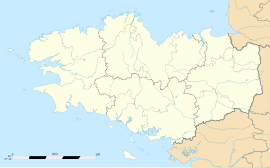world.wikisort.org - France
Quéven (French pronunciation: [kevɛ̃]; Breton: Kewenn) is a commune in the Morbihan department of Brittany in north-western France.[3]
Quéven
Kewenn | |
|---|---|
Commune | |
 Chapelle de la Trinité de Quéven | |
Location of Quéven  | |
 Quéven  Quéven | |
| Coordinates: 47°47′22″N 3°24′50″W | |
| Country | France |
| Region | Brittany |
| Department | Morbihan |
| Arrondissement | Lorient |
| Canton | Ploemeur |
| Intercommunality | Lorient Agglomération |
| Government | |
| • Mayor (2020–2026) | Marc Boutruche[1] |
| Area 1 | 23.93 km2 (9.24 sq mi) |
| Population | 8,770 |
| • Density | 370/km2 (950/sq mi) |
| Time zone | UTC+01:00 (CET) |
| • Summer (DST) | UTC+02:00 (CEST) |
| INSEE/Postal code | 56185 /56530 |
| Elevation | 2–66 m (6.6–216.5 ft) |
| 1 French Land Register data, which excludes lakes, ponds, glaciers > 1 km2 (0.386 sq mi or 247 acres) and river estuaries. | |
History
During World War I, Quéven lost one hundred and one of its children.
85% of the town was destroyed in World War II. In January 1945, the city of Toulouse adopted the ruined town, via its mayor Raymond Badiou. In memory of this help the main square of Quéven was renamed "Place de la ville de Toulouse" and a street in Toulouse was renamed "Rue de Quéven".[4]
The city of Queven has been honoured 25 September 1949 with Cross of War 1929-1945 by the citation 11 November 1948 of the Ministry of the Armed Force, Max Lejeune.
Population
Inhabitants of Quéven are called in French Quévenois.
| Year | Pop. | ±% p.a. |
|---|---|---|
| 1968 | 2,954 | — |
| 1975 | 4,529 | +6.30% |
| 1982 | 6,798 | +5.97% |
| 1990 | 8,400 | +2.68% |
| 1999 | 8,314 | −0.11% |
| 2007 | 8,744 | +0.63% |
| 2012 | 8,666 | −0.18% |
| 2017 | 8,676 | +0.02% |
| Source: INSEE[5] | ||
Twin towns
Quéven is twinned with:
- Dunmanway (Ireland)
- Koro (Mali)
- Altenkunstadt
- Weismain in Bavaria (Germany)
Breton language
The municipality launched a linguistic plan through Ya d'ar brezhoneg on 26 September 2008.
In 2008, there was 1,83% of the children attended the bilingual schools in primary education.[6]
See also
- Communes of the Morbihan department
- Entry on sculptor of Quéven war memorial Jean Joncourt
References
- "Maires du Morbihan" (PDF). Préfecture du Morbihan. 7 July 2020.
- "Populations légales 2019". The National Institute of Statistics and Economic Studies. 29 December 2021.
- INSEE commune file
- La place de la ville de Toulouse, Quéven au fil du temps
- Population en historique depuis 1968, INSEE
- (in French) Ofis ar Brezhoneg: Enseignement bilingue
External links
- Official website (in French)
- Base Mérimée: Search for heritage in the commune, Ministère français de la Culture. (in French)
- Mayors of Morbihan Association (in French)
На других языках
[de] Quéven
Quéven (bret.: Kewenn) ist eine französische Gemeinde mit 8770 Einwohnern (Stand: 1. Januar 2019) im Département Morbihan in der Region Bretagne. Sie liegt nahe der Atlantikküste im Arrondissement Lorient und im Kanton Ploemeur.- [en] Quéven
[ru] Кевен
Кевен (фр. Quéven) — коммуна на северо-западе Франции, находится в регионе Бретань, департамент Морбиан, округ Лорьян, кантон Плёмёр. Пригород Лорьяна, примыкает к нему с севера. Через территорию коммуны проходит национальная автомагистраль N165. Восточная граница коммуны проходит по реке Скорф. Юго-западную часть территории коммуны занимает аэропорт Лорьян-Южная Бретань.Другой контент может иметь иную лицензию. Перед использованием материалов сайта WikiSort.org внимательно изучите правила лицензирования конкретных элементов наполнения сайта.
WikiSort.org - проект по пересортировке и дополнению контента Википедии